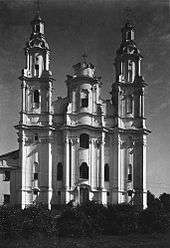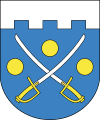Hlybokaye
| Hlybokaye Głębokie גלובאָק | |||
|---|---|---|---|
| Глыбокае Глубокое | |||
|
View of Glubokoye | |||
| |||
| Country | Belarus | ||
| Voblast | Vitebsk Region | ||
| Raion | Hlybokaye Raion | ||
| Population | |||
| • Total | 18,200 | ||
| Time zone | EET (UTC+2) | ||
| • Summer (DST) | EEST (UTC+3) | ||
| Post code | 220050 | ||
| phone area code: +375 2156, postal indices: 211791, 211792, 211800 | |||
Hlybokaye or Glubokoye (Belarusian: Глыбокае, Russian: Глубокое, Polish: Głębokie, Yiddish: גלובאָק) is a town in Vitebsk Region, Belarus, the capital of Hlybokaye Raion (Belarusian: Глыбоцкі раён). The city is located on the international road from Polotsk to Vilnius with the historic railway line to Woropajewo (Варапаева) completed in 1932 in the interwar Poland (the town was incorporated in 1940 by the Soviet Union after the 1939 invasion of Poland). It has 18,200 inhabitants as of 2010.[1]
Within the city limits there are two smaller lakes: Kahalnaye (Кагальнае) and Grand (Вялікае) from which the Birchwood river originates (Бярозаўка, Brzozówka in Polish). The first written records about the settlement date back to 1514. During World War II in occupied Poland the town's district of Berezwecz was the location of a massacre of up to 2,000–3,000 Polish prisoners by the Soviet NKVD secret police.[2][3] As late as 2009 the remains of more than 20 victims probably shot by NKVD after the takeover of the area from Poland were again discovered in a basement of a local church.[4]
History
The first mention of Głębokie in historical sources comes from 1414 and this date shall be considered as time of the founding of the first settlement. In 1514 Głębokie was included in the documents of the Grand Duchy of Lithuania as consisting of a manor house and a property owned by Zianowicz family.[1]
Poland's Second Republic
During Polish-Soviet War of independence, Głębokie was taken over by the Polish Army in December 1919, but in July 1920 found itself in the hands of the Bolsheviks as a result of the offensive by Tukhachevsky. On July 5, 1920 near Głębokie there was a battle in which some 1,500 soldiers died on both sides. In October 1920, the Poles regained the city. The incorporation of Głębokie into the Second Polish Republic was officially confirmed by the 1921 Treaty of Riga signed between Poland and the Soviet Union. It was given town status and became the administrative center of the Dziśnieński–Głębokie district and the seat of municipality. On February 19, 1921 Głębokie became part of Nowogródek Voivodeship (1919–39), from April 13, 1922 part of Ziemia Wileńska region, and on 20 January 1926 part of Wilno Voivodeship (1926–39). On November 10, 1933 the settlement of Gliniszcza was included within the boundaries of the town of Głębokie.[1]

According to the Polish census of 1921, some 2,844 Jews lived in Głębokie, accounting for 63% of its population. Just before the Soviet invasion of Poland in World War II, Głębokie had a population of 9,700. Most residents worked in either, confectionery factory, tannery, mill, county administration, private shops, and warehouses. Every Thursday market was held in the town's centre, and four times a year - country fairs. Also in the town stationed the Polish Border Protection Corps (KOP) regiment.
World War II and later
As a result of the Soviet invasion of Poland beginning September 17, 1939, the town was overrun by the Red Army and on November 2, 1939 incorporated into the Byelorussian SSR of the Soviet Union. It became part of the brand new Vileyka Voblast on December 4, 1939.[1] Hundreds of Poles were arrested by the NKVD and imprisoned on trumped-up charges.[3]
Following the German attack against Russian forces in eastern Poland known as Operation Barbarossa, the mass murder of former Polish nationals by the Soviets occurred in June 1941 during the evacuation of all prisons eastward through Vitebsk. The NKVD murdered up to several thousand prisoners from Głębokie.[3] The majority of prisoners were murdered in Daugava near Mikołajewie. The Germans established a Jewish ghetto in Głębokie. In July 1943 during the liquidation of the ghetto an uprising broke out in Głębokie organized by the Jewish anti-Nazi insurgents.
At the local Catholic cemetery, there are graves of both parents of the famous Polish writer Tadeusz Dołęga-Mostowicz, his father Stefan and mother Stanisława née Popowicz. In 1998, on the back wall of the house (now courthouse) which once belonged to Mostowicz family, a bilingual plaque was laid commemorating the writer.
In July 2009, in the Orthodox Nativity of the Blessed Virgin Mary the council during a work order found the remains faithful to the Poles. Screening is conducted, and the bones were buried, officially because of the odor.[1]
The flag and coat of arms
Hlybokaye flag and coat of arms were laid down 20 January 2006 Belarusian presidential ukase No. 36
Monuments
- Birth of the Virgin Cathedral - were dedicated to the church of the Discalced Carmelites. Assumption of the Blessed Virgin Mary (1730-1735).
- Church of Sts. Trinity in the Głębokie - the Catholic Church, the parish of the Holy Trinity was founded by Joseph Korsak governor in 1628. Church of St. Trinity is one of the few in what is now Belarus active continuously since the foundation.
- Church and Basilian monastery in Berezwecz - now part of the City Hlybokaye. Founded in 1637 by Joseph Korsak. Initially, wood, exposed brick in the years 1756-1767. Basilian Order scrapped in 1839, the monastery in the second half of the nineteenth century turned into an Orthodox monastery. Between the Catholic Church restored convent and monastery KOP placed. In September 1939, the NKVD in the prison set up rooms for Poles. Preserved monastic body. Pobazyliański Church, a beautiful example of baroque Vilnius, destroyed in 1970, the order of the local authorities. The remains of the Basilian monastery building is now in prison.
- Chapel Cemetery on "Kopciówce" - p. St. Elijah (seventeenth century) - the foundation of Joseph Korsak. Took care of the temple of the Carmelites (hence the call took St. Elias, the founder of the Order of Hermits of Mount Carmel). Approx. 1775 - reconstruction of the temple. In 1865 - taken to the church, 1921 - recovery of the Catholic chapel, known then as the church rector, "school" church. Sacred Heart of Jesus in the cemetery, 1928-1938 - Fr. Kazimierz Mirynowski (CAT). 1932 - Renovation of the temple, 1938 - rector of the church, Fr. Mirynowski also served chapels and Koraby Soroka. Currently unused.
- Buildings in Zakopane, the years 1920-1930. The city was built or rebuilt six houses in Zakopane style. They are on the streets Free and Komsomolskaya (former Narutowicza). Identical Braslav also built and Szarkowszczyźnie. All the houses were covered with metal roofing. The complex also been planted larches.
Cemeteries
- Cemetery "Kopciówka" - the old cemetery's headstone among other things, Elizabeth de Magnus Jelenski (Kulikowski), 1812-1879, the column commemorating the Constitution of 3 May 1791, headquarters of Polish soldiers who died in 1920, and the gate of the former monastery of the Carmelites bare. On the hill is visible church of St cemetery. Elijah. The cemetery overlooks the council Birth of the Virgin (the former church of the Discalced Carmelites).
- Jewish Cemetery
Destroyed monuments
- Radziwill Palace — Model year - after 1700. Lost - August 2005. In the place of the historic monument, with the permission of the authorities, built the store.
- Orthodox church. Trinity — Model year - XVII. Destroyed - 1880.
- Synagogue — built - about XVIII. Destroyed - after 1941.
People
- Pavel Sukhoi Soviet aircraft designer
- Tadeusz Dolega-Mostowicz - Polish writer, novelist, screenwriter
- Christopher Dorohostajski - Grand Marshal of the Lithuanian military commander, poet
- Claudius Duž-Duszewski - Belarusian political activist, writer, editor and translator
- Witold Glinski - exile, a participant of the famous escape from the gulag
- Irenaeus Ihnatowicz - Polish historian, archivist, professor at the University of Warsaw
- Joseph Korsak - Governor, founder of the church in Głębokie
- Samuel Mohylewer - for many years the chief rabbi of the Jewish community of Bialystok
- Sigmund Rudomino - Polish Admiral, infantry soldier and marine deck officer submarines
- Leonard Rzeczycki - Polish photographer
- Michaś Zuj - Belarusian national activist
References
- 1 2 3 4 5 This article incorporates general information translated from the corresponding article in Polish Wikipedia.
- ↑ G.C. Malcher, (1993) Blank Pages, Pyrford, ISBN 1-897984-00-6. Page 13.
- 1 2 3 Tadeusz Piotrowski, Poland’s Holocaust McFarland, ISBN 0-7864-0371-3. Page 17.
- ↑ 'Stalin victims' found in Belarus. The BBC News. 24 July 2009
External links
"Despite Everything...I had Won" - by Michael Etkin, published in Israel, in 2007
- http://www.amazon.co.uk/Despite-Everything-Won-Menachem-Etkin-ebook/dp/B00EBSOIFA
- hotos at radizmaust Memorial) Book (Yiddish)
- Book on Jews of Gluboke/Globoke/Hlybokaye
- post codes
Coordinates: 55°08′N 27°41′E / 55.133°N 27.683°E



